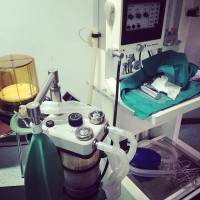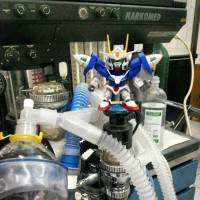Rhinoplasty Anesthesia Options
Local or general can be administered, but I generally perform the surgery under general anesthesia for the safety and comfort of patients. (Jerome Edelstein, MD, Toronto Plastic Surgeon)
General anesthesia is generally my preference as it very safe even though there are a lot of misconceptions.
A breathing tube is inserted which has a cuff that protects your airway during surgery.
Twilight anesthesia can be used as another good option for those that do not want general. This is done intravenously.
As always, make sure your surgeon sends you for a full work-up before undergoing any procedure with anesthesia for rhinoplasty.
Also, your potential anesthesiologist should be available via phone before the surgery to answer any additional concerns. (Philip Miller, MD, New York Facial Plastic Surgeon)
I prefer General Anesthesia given by a board certified plastic surgeon. I perform my surgeries in an out patient surgery center, and under general anesthesia.
I use Board Certified Anesthesiologists who monitor my patients from start to end so as to provide the safest environment for my patients.
I would recommend general anesthesia for rhinoplasty surgery so that you are as comfortable as possible during the procedure.
I would suggest that you be very careful with your surgeon selection and experience. Safety should be the first priority in every surgery. (Tom J. Pousti, MD, FACS, San Diego Plastic Surgeon)
Anesthesia options for Rhinoplasty
The type of anesthesia used for rhinoplasty depends primarily on the surgeon’s preference and comfort level. The most commonly used anesthetic methods are general anesthesia, local with IV sedation and/or monitored anesthesia.
The patient’s safety and comfort is of utmost importance and this should guide the surgeon as to the type of anesthetic used. (Sarmela Sunder, MD, Los Angeles Facial Plastic Surgeon)
Anesthesia for a rhinoplasty
It is possible to undergo a rhinoplasty with intravenous sedation, or general anesthesia. When Intravenous sedation is used, some conscious awareness of the procedure may occur, and for some patients this may be undesirable.
In our practice we perform rhinoplasty under general anesthesia for patient safety and comfort. We use board certified physician anesthesiologists. For many examples and more information about anesthesia, please see the link below to our rhinoplasty photo gallery (William Portuese, MD, Seattle Facial Plastic Surgeon)
Your surgeon is the captain of your ship and the artist you have chosen. Tell him to do what he is most comfortable with and do not try to make him compromise to do a procedure he is not comfortable with. Usually anesthesia costs are calculated by the time you are in the operating room and it does not make a difference whether you are awake or under general anesthesia (assuming there is a qualified anesthesia person present). Most anesthesiologists would rather have you under general anesthesia for rhinoplasty as they want to have total control of your airway, an important fact especially when you are undergoing “airway surgery”. (Robert E. Zaworski, MD, Atlanta Plastic Surgeon)
What Anesthesia is Used for a Rhinoplasty
Although local anesthesia and IV sedation is used by many surgeons I prefer to use general anesthesia for my patients. I feel that this control of the patient is necessary to achieve my best results. (Paul Vitenas, Jr., MD, Houston Plastic Surgeon)
Depending on the scope of surgery and your preference, we perform rhinoplasty with either general anesthesia or iv sedation. (Kris M. Reddy, MD, FACS, West Palm Beach Plastic Surgeon)
Sedation is great
I do most of my rhinoplasties under IV sedation. An anesthesiologist (MD) gives you medication so you sleep through the procedure. It is safe and effective and avoids a tube in your airway. We have been doing this for over 30 years, and our patients are quite happy. (William B. Rosenblatt, MD, New York Plastic Surgeon)
The type of anesthesia used for nose job surgery depends on the amount of work that will need to be done and the patients and the doctors preference.
For example, if you only want or need your tip worked on, you can have this done under a local anesthesia (numbing the tissues), or you can choose to have IV sedation or a General Anesthesia if you are frightened of experiencing the process.
If however you need extnesive internal work performed, you will likely need a General Anesthesia so that you do not experience the pain, and so that your airway can be protected during surgery. (Amy T. Bandy, DO, FACS, Newport Beach Plastic Surgeon)
Most nose job surgery is performed under deep sedation or general anesthesia. The reason for this is two-fold: There is always some bleeding that can get into your airway during the surgery, so general anesthesia, where a breathing tube is used, protects your airway.
No one really wants to be awake for this procedure, no because there is pain, but because its just uncomfortable for most to be aware of the procedure.
That being said, some minor procedures can be performed under minor sedation with local anesthesia. It all depends on what needs to be done. (Oleh Slupchynskyj, MD, FACS, New York Facial Plastic Surgeon)
General Anesthesia for nose job
General anesthesia is typically used for nose job. There are some surgeons who might use twilight sleep but there are not too many.
General anesthesia is the most comfortable of all and is very safe in healthy individuals. (Tanveer Janjua, MD, Bedminster Facial Plastic Surgeon)
Anesthesia for nose job
The 2 most common forms of anesthesia used in nose job surgery are either Intravenous sedation with local infiltration of the nose AND General Anesthesia both of which require careful monitoring of the patients vital signs (Oxygen in the blood, pulse and blood pressure).
In both forms, the patient will have no feeling nor memory of the surgery. With general anesthesia the anesthetics are administered through the airway and are rapidly reversed once the anesthetic gas is stopped and replaced with Oxygen.
With IV sedation, awareness and consciousness are depressed with large doses of intravenous medications. This type of anesthesia has to be chemically reversed at the end of the case. Which one to use? Ask your surgeon for his/her preference. (Peter A. Aldea, MD, Memphis Plastic Surgeon)
The choice of anesthesia has to suit your health history as well as the surgeon’s comfort
While nasal reshaping, nose job can be done either under monitored anesthesia c are (IV sedation and supplemented local anesthesia) or general anesthesia (endotracheal intubation +/- local anesthesia), the most optimal choice is the one which will be support your unique health history as well as enable the surgeon to work efficiently and without distraction.
I have had elderly patients with traumatic panfacial fractures, including displaced nasal fractures who are scheduled under general anesthesia with cardiac clearance and inpatient observation afterwards. Alternatively, if you are a healthy individual who has extreme anxiety, IV sedation may not be a great option.
While I generally prefer MAC (IV sedation), I always review the patient’s past medical history and include them in the discussion. (Lavinia K. Chong, MD, Orange County Plastic Surgeon)
Anesthesia for Rhinopalsty
Nose job is best preformed while the patient is comfortable, not moving, experiencing no pain.
Although many of these operations are now preformed under general anesthesia, an experienced and conservative anesthesiologist will be able to keep the patient feeling comfortable with sedation anesthesia provided through intravenous access. At Lasky Clinic in Beverly Hills, almost all of our nose job procedures are preformed with local anesthesia and intravenous sedation. I have found this procedure to be most comfortable for patients who have nausea or nervousness while waking up from general anesthesia. I also prefer having the patients wake up, recover, and go home faster than with general anesthesia. I have also had several patients who are singers, and performers – all of whom really appreciate the reduced risk to their vocal cords. What is most important is that your surgeon and your anesthesiologist are both comfortable with the method chosen for your given procedure. (Behrooz Torkian, MD, Beverly Hills Facial Plastic Surgeon)
Anesthesia used in nose job
There are two types that are usually used – general anesthesia and local with IV sedation. Local anesthesia alone may be used for a minor procedure on the nose, but not for nose job. With general anesthesia, the patient is put completely to sleep with a tube passed through the throat which administers the anesthetic gases and keeps blood from the back of the nose from going into the lungs.
With local anesthesia and IV sedation, a drug is given through a vein in your arm or hand which causes you to lose consciousness and the nose is injected with a local anesthetic. With the nose anesthetized, less drug through the vein is used to keep you semi-conscious but you have to be conscious enough to breath on your own so if blood enters the lungs, you will still have a cough reflex and be able to clear your airway. (Jack P. Gunter, MD, Dallas Plastic Surgeon)
Local anesthesia, IV sedation, or general inhalation anesthesia may be used during nose job surgery. Don’t be influenced by marketing terms.
In most cases, IV sedation is a form of general anesthesia. Working with The Medical Board of California, I was one of a group of physicians asked to help define ” general anesthesia”.
Accepting the recommendation of the commitee, the Board said it was the administration of drugs that take away the patient’s life-preserving reflexes. This will happen duing your nasal surgery. Regardless of technique, minimal anesthetic will be given. (Richard W. Fleming, MD, Beverly Hills Facial Plastic Surgeon)
Nose job anesthesia
There are three general categories of anasthesia for nose job:
- Local anesthesia
- Twilight / Sedation Anesthesia
- General anesthesia
The type of anesthesia used will depend upon the amount of work that needs to be done on your nose, your surgeon’s preference, the aneshtesiologist preference, and your preference.
Anesthesia techniques are extremely safe today. View on the link below for more in depth information about anesthesia for nose job. (Jacob D. Steiger, MD, Boca Raton Facial Plastic Surgeon)
Rhinoplasty sedation depends on amount of work needed
Rhinoplasty is most commonly performed under intravenous sedation with local anesthesia or under a general anesthetic.
A Rhinoplasty could be performed by the surgeon after simply injecting your nose with a local anesthetic much like a dentist does when filling a cavity.
Obviously, the patient is completely awake in this circumstance. However only the most minor of cosmetic adjustments to the nose can be accomplished under a local anesthetic alone.
More often the rhinoplasty requires, for patient comfort, that the local anesthetic to be supplemented with intravenous sedation commonly called twilight sleep.
This means that sedative, tranquilizing and pain medications are given to the patient intravenously making them unaware of the goings on but still breathing on their own.
Under this technique the patient does not feel the injections of the local anesthetic and is kept sedated in a semiconscious state throughout the operation.
Some surgeons feel confident in administering the sedation themselves and others prefer to have an anesthesiologist or nurse anesthetist perform the sedation. A third alternative is the use of General Anesthesia.
This form of anesthesia begins by first sedating the patient and then a breathing tube is inserted in their windpipe. A anesthetic gas is delivered through the tube creating a deep anesthetic state.
Oxygen is given as well because the patient is no longer breathing on their own. General anesthesia requires the presence of an anesthesiologist or a nurse anesthetist.
Each surgeon has their own particular preference of anesthetic. All are equally safe given a healthy patient and a competent group of medical personnel delivering the anesthetic.
I personally prefer to utilize General Anesthesia for my Rhinoplasty surgeries. (David A. Ross, MD, Chicago Plastic Surgeon)
Anesthesia for rhinoplasty
Anesthesia options include intravenous sedation, monitored anesthesia care, or general anesthesia. Intravenous sedation and monitored anesthesia care are at one end of the spectrum where patient is awake but calm (iv sedation) to breathing on own but very sedated.
General anesthesia is at the other end where patient needs an endotracheal tube to breathe (ventilate). All are reasonable options and depend on the surgeon’s preference and patient’s health. We prefer monitored anesthesia care where the patient is breathing on own but has the airway protected. This allows us to perform rhinoplasty without worrying about competing for the patient’s airway. (Corey S. Maas, MD, San Francisco Facial Plastic Surgeon)
The options are local (you are fully awake) IV sedation (you are not aware of what is going on but are breathing on your own) and general (you out out and a machine is breathing for you). The specific choice that is best for a patient depends on what surgery is being performed, the patent’s health and pain tolerance, the surgeon’s experience and the overall cost to the patient. (Jay M. Pensler, MD, Chicago Plastic Surgeon)
Less Rhinoplasty recovery with IV sedation
The majority of my rhinoplasties are with IV sedation. The patient has less bruising, nausea and bleeding as with general anesthesia. General anesthesia may be indicated in very long complicated revision cases. Overall, I would go with your surgeons preference. General anesthesia may be easier for some Docs as this was the manner they were trained. (J. Smythe Rich, MD, Columbia Plastic Surgeon)
Acceptable anesthesia for Rhinoplasty
The level of Anesthesia for Rhinoplasty depends largely on 2 factors: the amount of work needed and the comfort level of the patient. Most often, Rhinoplasties are peformed under general anesthesia, but short, focused procedures can be done with local anesthesia. Longer cases are best performed with the enhanced patient comfort afforded by sedation or general anesthesia. (Randolph Capone, MD, Baltimore Facial Plastic Surgeon)
Rhinoplasty for anesthesia is patient dependent
The type of anesthesia that you choose for rhinoplasty often depends upon your preference. If you do not want to feel anything whatsoever and do not want to see or hear the surgeon who is working on your nose then I would recommend general anesthesia.
However, if you fear being put to sleep then intravenous anesthesia or conscious sedation can be used where you are given relaxation and pain medication but can have some awareness of your surroundings and potentially remeber some of the surgery especially the work that is being done on the bony part of your nose. In some individuals, even local anesthesia can be used but the needle sticks to numb up the nose for surgery can be painful but if you are only having a small “tweak” done or a limited rhinoplasty, that way is an option. (Scott Trimas, MD, Jacksonville Facial Plastic Surgeon)
General anesthesia used for rhinoplasty
Unless the work is minor, general anesthesia is advised for a rhinoplasty. The nose has a plethora of pain fibers and anesthestizing with sedation and local, while possible, is extremely painful. Any drainage from the operation can drip onto the larynx and cause dangerous spasm. (Vincent N. Zubowicz, MD, Atlanta Plastic Surgeon)


